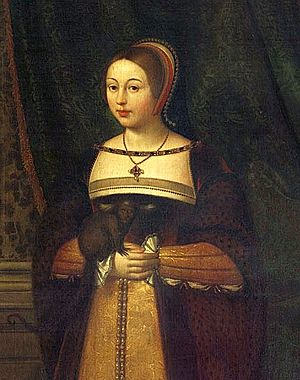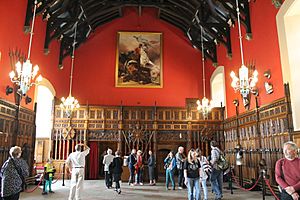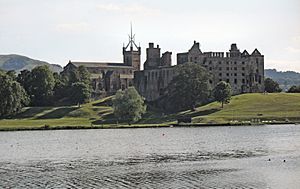Ellen More facts for kids
Ellen or Elen More was an African servant who lived at the Scottish royal court around 500 years ago. She probably came to Scotland with a Portuguese man and some interesting animals. Records show she received clothes and gifts, but her exact job and importance are not fully clear. Some historians think she might have been brought to Scotland against her will, linked to the history of people being forced into service. She is also connected to a poem by William Dunbar and might have performed as the "Black Lady" in royal tournaments in Edinburgh in 1507 and 1508.
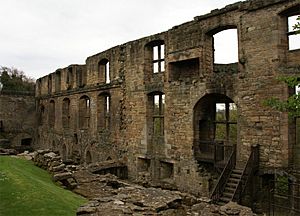
Contents
Who Was Ellen More?
Ellen More worked at Edinburgh Castle for Lady Margaret, who was the daughter of James IV of Scotland. Later, Ellen More served Margaret Tudor, the Queen of Scotland, at Linlithgow Palace.
Her name, "Elen More," first appeared in royal records in December 1511. She was last mentioned in August 1527 as "Helenor the blak moir." The name "More" in these Scottish records likely came from the word "moor," which was used to describe an African person at that time.
African People at European Courts
African servants also worked at other royal courts in Europe during this period. For example, in Italy, Isabella d'Este wanted a young Black girl to serve her in Mantua. She also had an older African girl who was being trained as an entertainer. Just like in Scotland, African themes and exotic animals were part of royal celebrations in these courts.
In England, African servants were part of the household of Catherine of Aragon, the Spanish princess who married Henry VIII. These servants included a trumpeter named John Blanke.
Exotic Animals at Royal Courts
In 1504, four African women, called "More lasses," arrived in Scotland with a Portuguese man and some animals. These animals included a cat and a horse. This was during the time of Portuguese exploration, when Europeans were making strong connections with Africa.
Portuguese kings were known for collecting rare animals from far-off lands. They often sent these animals as gifts to other royal courts. For instance, Henry VII of England received parrots and wild cats. The Scottish court also had a pet monkey called the "Marmoset of Calicut." This name shows the Portuguese were active in places like India and Brazil.
A portrait of Queen Margaret Tudor even shows her with a Brazilian marmoset. This might be a copy of a painting once owned by Henry VIII.
How People and Animals Arrived in Scotland
King James IV allowed Scottish ships, called privateers, to attack Portuguese ships. This was because of a disagreement about a lost cargo. These privateer activities might have been one way African people came to Scotland, though there is no direct proof.
Records about the "More lasses," the Portuguese man, and the exotic animals were found again in the 1800s. Some historians thought that the African people at the Scottish court might have arrived because of the success of these Scottish privateers.
James IV also had other connections to Portuguese trade. He hired Portuguese craftspeople for his shipyards and bought spices from Portuguese merchant ships. The arrival of these African people in Scotland is still a bit of a mystery. However, royal records show that African people like "Peter the More" and the "More taubronar" (a drummer) were part of James IV's royal household.
Ellen More in Royal Records
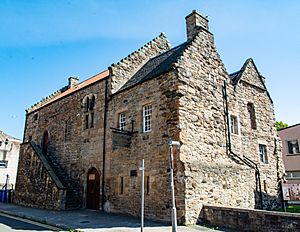
The "More Lasses" on the Move
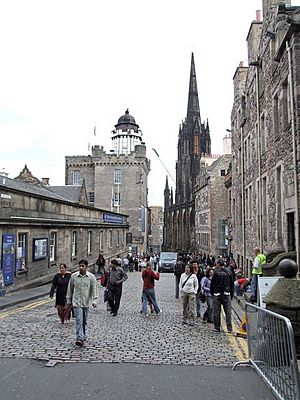
In October 1504, Queen Margaret Tudor was at Dunfermline Palace. There was a worry about the plague, so the queen and her household left Dunfermline. Four African women, called "More lasses," traveled to North Queensferry and Inverkeithing on November 8. They were looked after by the court's doctor, John Mosman. Other people and some animals were with them. After a few days, they went to Edinburgh.
Staying in Edinburgh
King James IV arrived in Edinburgh in November. On November 22, he rewarded a man who had brought animals that had been with the African women. These animals included a Portuguese horse with a red tail and a civet or "must cat."
At first, the four African people, described as "Ethiopians," stayed at the house of James Hommyll, a rich Edinburgh merchant. Hommyll also hosted the Portuguese man who had brought them to Scotland, along with the horses and other animals. They stayed there for 40 days. Hommyll's house was on the south side of the High Street, near Edinburgh Castle.
Baptism and New Names
One of the "More lasses" was christened (baptized) on December 11, 1504, and likely given a new name. This might have been when they moved from James and Helen Hommyll's house back to the royal household. Ellen More might have been named after a courtier, Eleanor Pole, or Helen of Troy. Her sister might have been named Margaret after the queen. Some historians think Ellen More and other African people arriving in Scotland might have followed the Islamic faith. The word "lass" usually meant a teenager at that time.
Ellen More's Life at Court
These records from 1504 likely refer to the arrival of Ellen and her sister Margaret. Ellen and Margaret seem to be the two "More lassis" at Edinburgh Castle who served Lady Margaret and received new shoes.
In 1506, Ellen and Margaret were given gowns of russet cloth with velvet bands and red skirts. In 1507, they received red skirts with green ribbons.
Later, they joined Queen Margaret Tudor's court. They received clothes and New Year's Day gifts, similar to those given to the queen's English lady-in-waiting. Ellen worked for the queen at Linlithgow Palace. For example, on January 1, 1512, Ellen More received five French gold coins as a New Year's gift.
Ellen or Elen More was first mentioned by name in royal records in December 1511. She received her "livery clothes," which was an allowance of clothing given to many royal servants before Christmas. These clothing gifts were often more valuable than the money servants received. The type of clothing showed a person's status at court.
Ellen More's clothes included a gown made of brown cloth from Lille, trimmed with velvet, with yellow taffeta sleeves, a velvet hood, and a skirt of brown wool with a crimson hem. Margaret More is mentioned less often, but she was at Linlithgow Palace in April 1512 when James V of Scotland was born. On January 1, 1513, the "two black ladies" received 10 gold coins. Some historians believe these "two black ladies" were Ellen and Margaret More, connecting them to earlier "Black Lady" tournaments.
Ellen More received 40 shillings in July 1527, recorded as a payment to "Helenor, the blak moir." After this, we don't know for sure what happened to Ellen and Margaret More.
The Poem "Of Ane Blak-Moir"
The poet William Dunbar wrote a poem for James IV's court called Of Ane Blak-Moir. This poem describes a Black woman who was part of a tournament. The poem uses very unkind and prejudiced language.
King James IV held two grand tournaments called "The justing of the wyld knicht for the blak lady" (The jousting of the wild knight for the black lady) in June 1507 and May 1508. A woman from the court played the part of the "Black Lady." King James IV himself played the "Wild Knight," a character from the stories of King Arthur.
It's not clear if Dunbar's poem was directly about these tournaments or if Ellen More played the "Black Lady." The identity of Ellen More, the woman in the poem, and the performer in the tournaments is still discussed by historians. The role of the Black Lady as a "prize" in the tournament might have shown that African performers were seen as property at that time.
The poem begins by saying the woman arrived in Scotland on a ship. Dunbar says he is writing about a Black woman after writing about white women of the court. The poem creates a very negative comparison between the Black woman's appearance and that of the white ladies at court:
- Lang have I made of ladies white,
- Now of ane black I will indite,
- That landit furth of the last ships,
- Who fain I would descrive perfyte.
The Black Lady Tournaments
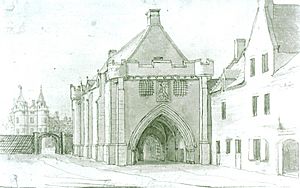
These very expensive events, which copied the "Round Table" tournaments of King Arthur in England, were recorded in royal accounts. Invitations to the tournament were even sent to France.
The Black Lady's gown was made from fancy fabric with gold flowers, trimmed with yellow and green. She had black gauze sleeves and a drape over her shoulders. She also wore long black leather gloves. She had two female companions dressed in green gowns.
Two knights, William Ogilvy and Alexander Elphinstone, 1st Lord Elphinstone, dressed in white as the "Squires of the Black Lady." They escorted her from Edinburgh Castle to the tournament field. She was carried in a special "triumphal chair" decorated with flowers. James IV himself played the "Wild Knight." The horses pulling the carts were also dressed in rich fabrics. One horse was even disguised as a unicorn. The Black Lady was carried by 12 men from Edinburgh Castle to the tournament ground and then to Holyrood Palace.
The tournaments lasted five weeks. Challengers gathered at the "Tree of Esperance" (Tree of Hope) at the tournament ground. The Black Lady kept the week's white shield there, with "wild men" by her side. Jousts and fights were judged by ladies of Queen Margaret Tudor's court. The Tree of Hope was decorated with fake flowers and painted shields.
The events ended with three days of banquets at Holyroodhouse. There was a play and a dance. The Black Lady came into the hall with Martin the Spaniard, who had a bow and was dressed in yellow. Then, a cloud came down from the roof and made them both disappear! This was a special effect created by a French soldier and Andrew Forman.
African People in Court Plays
Records from the 1500s show that court plays included both performers of African origin and performers dressed up as "moors" (imagined African people). In 1504 and 1505, James IV had an African drummer known as the "More taubronar" (Moorish drummer). This drummer traveled with the king and even created a dance for a tournament.
Later Scottish court events also featured African actors or actors pretending to be African. These included the entry of Mary, Queen of Scots into Edinburgh in 1561, her wedding in 1565, and the baptism of James VI in 1566. The costumes for the "Black Lady" in James IV's tournaments included a light black fabric around her arms. In England, female performers in plays sometimes covered their faces and arms with similar black fabric to appear as "black Moors."
A Danish observer in 1590 noted that some townspeople wore masks and had painted legs and arms, while there was also "an absolutely real and native blackamoor." An African servant at the Scottish court was buried at Falkland Palace in 1591. In 1594, an African performer pulled a decorated cart at a feast in Stirling Castle.
In Shakespeare's play Othello, a character remembers her mother's maidservant, a Moorish woman. This play was performed in 1604. In 1605, Queen Anne of Denmark and her ladies performed in "black face" in a play called The Masque of Blackness. These performances show how African people were seen and represented in plays during that time, especially as Europeans were exploring and meeting people from different parts of the world.
Ellen More in Modern Media
Ellen More is featured in a short animated film called "The Tournament of the African Lady." This film also shows John Blanke, a trumpeter at the English court.
Her story is also the basis for a stage play titled James IV: Queen of the Fight, written by Rona Munro, which was performed in 2022.
Images for kids
-
Margaret Tudor, possibly depicted with her pet, the "Marmoset of Calicut", Daniël Mijtens, RCT.
See also


